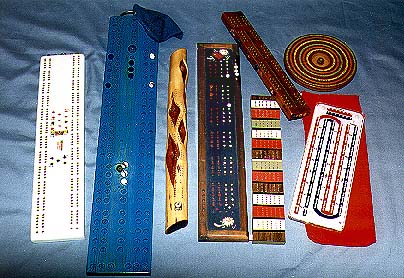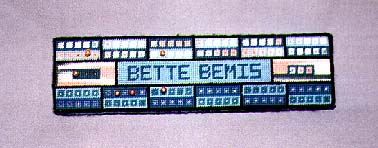♠ Article Library ♦ Board Gallery
For most cribbage players, the common forms of boards on which they play are the tournament long board or one of the colorful once-around styles that are manufactured primarily in the Far East countries such as Taiwan. Of course, the next most common style board used is one which has been passed down in the family. When playing on these boards, the nostalgia of remembering who has played on it before you, possibly the person who taught you the game, gives you a sense of satisfaction that the board has been preserved. Many of these boards were hand-crafted one or two, possibly three generations before it ever reached your hands, so the intrinsic value to you is far greater than the book value. While reviewing hundreds of photos of hand-crafted boards for this article, I was struck by the great variety of styles, shapes, materials from which they have been made. We are creative animals, to say the least!
My own personal treasure was created by my grandfather in the early 1900's, possibly before he immigrated to this country from England. It was made from a brass plate on wood, with a pivot at the end for peg storage. It features twice-around pegging, for, as stated in an earlier article, play to 121 points for Game didn't become established until the mid-30's. I learned how to play cribbage on this board from grandfather, and as roughly crafted as it is, the fact that there is one extra set of double holes, does not deter me from featuring it as my favorite board!

In the photo of assorted colorful boards, only three are manufactured. The board on the left is currently being manufactured by a company called Custom Cribbage, and the craftsmanship is top quality. The red-white-blue board on the right was manufactured by a firm in New England , and is of acrylic with a decal on the underside. The round board (T-R), which was featured in my last article, was manufactured over 50 years ago by Acme ruler and Advertising Co., Ltd. Of Toronto, Canada.
The large turquoise board uses marbles instead of pegs, and it is hand-crafted by The Marble Man and his spouse, who live in Virginia. The marbles are also created from crushed glass by him, and the board can be purchased in a variety of colors. Believe it or not, the board plays well, but I won't guarantee that you will win every time!
Located toward the center is a board crafted in Alaska of Diamond Willow. The wood, which is indigenous to Alaska, is a stunning example of nature's creativity, and it is difficult to believe that the diamonds weren't carved by Man. Examples of the wood are rarely seen in the lower 48, giving it even more mystique. The board needs no other artwork to give it a special character, and it looks great in the center of a collection.
The multi-colored board was created from small inlays of Formica by a local craftsman. The board itself is roughly made, but the inlays give the board its own special glamour. On the underside, I discovered the name of the craftsman as well as the name of the person for whom the board was made, which is of additional interest to a board collector. My collection happens to house several boards hand-crafted locally, and I plan to preserve the names of the craftsmen with their boards. Who knows, a hundred years from now one of their descendents may have an opportunity to gain possession of their board, and it will become a family treasure!

This creative once-around board was hand-crafted by a couple from Wyoming, Donnie and Dollie Lewis. One of the unique features of the board is that no one gets skunked when playing on it! Instead of skunk lines, the board features brass cowboys - so the player stands the risk of being "Cowboyed" instead of being "Skunked".

When reviewing hand-crafted boards, we have to realize that almost any material can be used in the creative process. This board, for example, is created out of Quick Point, and any combination of colors can be used. This style first came to my attention when a collector sent me a photo of a Quick Point board featuring "Z's" down the center. I tried to find the source of a pattern, but to no avail. Finally, in sheer frustration, I created my own pattern in order to have a board for display. I have to admit that the board is not very playable, so it would not ever become a "hot" item in the general marketplace!
As I stated earlier, there are boards of all designs - fish, trucks, aircraft carriers, Hawaiian outriggers, cacti, Santas, Uncle Sams, - you name it, it has been created . For the novice collector, these boards can be acquired inexpensively at most flea markets and yard sales , and they give colorful character to a collection. Unless the creator becomes famous, the boards will not appreciate much in value, helping to maintain the affordability a owning a colorful and expressive collection!